Synthesis of Trithia-Borinane Complexes Stabilized in Diruthenium Core: [(Cp*Ru)2(η1-S)(η1-CS){(CH2)2S3BR}] (R = H or SMe)
Abstract
1. Introduction
2. Results and Discussion
Synthesis of Ruthenium Borinane Complexes, 2–4
3. Materials and Methods
3.1. General Procedures and Instrumentation
3.2. Synthesis
3.2.1. Synthesis of Compounds 2, 3, and 4
3.2.2. Synthesis of Compound 5
3.3. X-ray Crystallography
4. Conclusions
Supplementary Materials
Author Contributions
Funding
Acknowledgments
Conflicts of Interest
References
- Hartwig, J.F.; Muhoro, C.N.; He, X.; Eisenstein, O.; Bosque, R.; Maseras, F. Catecholborane Bound to Titanocene. Unusual Coordination of Ligand σ-Bonds. J. Am. Chem. Soc. 1996, 118, 10936–10937. [Google Scholar] [CrossRef]
- Douglas, T.M.; Chaplin, A.B.; Weller, A.S. Amine–Borane σ-Complexes of Rhodium. Relevance to the Catalytic Dehydrogenation of Amine–Boranes. J. Am. Chem. Soc. 2008, 130, 14432–14433. [Google Scholar] [CrossRef] [PubMed]
- Forster, D.; Tuononen, H.M.; Parvez, M.; Roesler, R. Characterization of β-B-Agostic Isomers in Zirconocene Amidoborane Complexes. J. Am. Chem. Soc. 2009, 131, 6689–6691. [Google Scholar] [CrossRef] [PubMed]
- Tang, C.Y.; Thompson, A.L.; Aldridge, S. Rhodium and Iridium Aminoborane Complexes: Coordination Chemistry of BN Alkene Analogues. Angew. Chem. 2010, 122, 933–937. [Google Scholar] [CrossRef]
- Crossley, I.R.; Foreman, M.R.S.J.; Hill, A.F.; White, A.J.P.; Williams, D.J. The first rhodaboratrane: [RhCl(PPh3){B(mt)3}](Rh→B) (mt = methimazolyl). Chem. Commun. 2005, 221–223. [Google Scholar] [CrossRef] [PubMed]
- Ghosh, S.; Lei, X.; Shang, M.; Fehlner, T.P. Role of the Transition Metal in Metallaborane Chemistry. Reactivity of (Cp*ReH2)2B4H4 with BH3·thf, CO, and Co2(CO)8. Inorg. Chem. 2000, 39, 5373–5382. [Google Scholar] [CrossRef] [PubMed]
- Greenwood, N.N.; Ward, I.M. Metalloboranes and metal–boron bonding. Chem. Soc. Rev. 1974, 3, 231–271. [Google Scholar] [CrossRef]
- Grimes, R.N. Structure and stereochemistry in metalloboron cage compounds. Acc. Chem. Res. 1978, 11, 420–427. [Google Scholar] [CrossRef]
- Fehlner, T.P. A molecular orbital analysis of four chromaboranes: On the curious behavior of (η5-C5R5)Cr fragments in a borane cluster environment. J. Organomet. Chem. 1998, 550, 21. [Google Scholar] [CrossRef]
- Ghosh, S.; Beatty, A.M.; Fehlner, T.P. The Reaction of Cp*ReH6, Cp* = C5Me5 with Monoborane to Yield a Novel Rhenaborane. Synthesis and Characterization of arachno-Cp*ReH3B3H8. Collect. Czech. Chem. Commun. 2002, 67, 808–812. [Google Scholar] [CrossRef]
- Sahoo, S.; Reddy, K.H.K.; Dhayal, R.S.; Mobin, S.M.; Jemmis, E.D.; Ghosh, S. Chlorinated Hypoelectronic Dimetallaborane Clusters Synthesis, Characterization, Electronic Structures of (η5-Cp*W)2B5HnClm (n = 7, m = 2; n = 8, m = 1). Inorg. Chem. 2009, 48, 6509–6516. [Google Scholar] [CrossRef] [PubMed]
- Dhayal, R.S.; Sahoo, S.; Reddy, K.H.K.; Mobin, S.M.; Jemmis, E.D.; Ghosh, S. Vertex-Fused Metallaborane Clusters: Synthesis, Characterization and Electronic Structure of [(η5-C5Me5Mo)3MoB9H18]. Inorg. Chem. 2010, 49, 900–904. [Google Scholar] [CrossRef] [PubMed]
- Ghosh, S.; Noll, B.C.; Fehlner, T.P. Expansion of Iridaborane Clusters by Addition of Monoborane. Novel Metallaboranes and Mechanistic Detail. Dalton Trans. 2008, 371–378. [Google Scholar] [CrossRef]
- Geetharani, K.; Krishnamoorthy, B.S.; Kahlal, S.; Mobin, S.M.; Halet, J.-F.; Ghosh, S. Synthesis and Characterization of Tantalaboranes. Comparison of the Geometric and Electronic Structures of [(Cp*TaX)2B5H11] (X = Cl, Br and I). Inorg. Chem. 2012, 51, 10176–10184. [Google Scholar] [CrossRef] [PubMed]
- Ghosh, S.; Noll, B.C.; Fehlner, T.P. Borane Mimics of Classic Organometallic Compounds: [(Cp*Ru)(B8H14)(RuCp*)]0,+1 Isoelectronic Analogues of Dinuclear Pentalene Complexes. Angew. Chem. Int. Ed. 2005, 44, 6568–6571. [Google Scholar] [CrossRef] [PubMed]
- Housecroft, C.E.; Fehlner, T.P. Triborane. A transition metal ligand or heterocluster fragment? Inorg. Chem. 1982, 21, 1739. [Google Scholar] [CrossRef]
- Housecroft, C.E. Boranes and Metallaboranes; Ellis Horwood: Chichester, UK, 1990. [Google Scholar]
- Mingos, D.M.P. Inorganometallic Chemistry; Fehlner, T.P., Ed.; Plenum: New York, NY, USA, 1992. [Google Scholar]
- Hoffmann, R. Building Bridges Between Inorganic and Organic Chemistry (Nobel Lecture). Angew. Chem. Int. Ed. 1982, 21, 711–724. [Google Scholar] [CrossRef]
- Chakrahari, K.K.V.; Dudekula, S.; Barik, S.K.; Mondal, B.; Varghese, B.; Ghosh, S. Hypoelectronic Metallaboranes: Synthesis, Structural Characterization, and Electronic Structures of the Metal-Rich Cobaltaboranes. J. Organomet. Chem. 2014, 749, 188–196. [Google Scholar] [CrossRef]
- Geetharani, K.; Bose, S.K.; Pramanik, G.; Saha, T.K.; Ramkumar, V.; Ghosh, S. An Efficient Route to Group 6 and 8 Metallaborane Compounds: Synthesis of arachno-[Cp*Fe(CO)B3H8] and closo-[(Cp*M)2B5H9] (M = Mo, W). Eur. J. Inorg. Chem. 2009, 1483–1487. [Google Scholar] [CrossRef]
- Roy, D.K.; Mondal, B.; Shankhari, P.; Anju, R.S.; Geetharani, K.; Mobin, S.M.; Ghosh, S. Supraicosahedral Polyhedra: Synthesis and Structural Characterization of 12, 15 and 16-vertex Rhoda-boranes. Inorg. Chem. 2013, 52, 6705–6712. [Google Scholar] [CrossRef]
- Geetharani, K.; Bose, S.K.; Sahoo, S.; Mobin, S.M.; Ghosh, S. Cluster Expansion Reactions of Group 6 and 8 Metallaboranes Using Transition Metal Carbonyl Compounds of Gr 7-9. Inorg. Chem. 2011, 50, 5824–5832. [Google Scholar] [CrossRef] [PubMed]
- Roy, D.K.; Bose, S.K.; Anju, R.S.; Ramkumar, V.; Ghosh, S. Synthesis and Structure of Dirhodium Analogue of Octaborane-12 and Decaborane-14. Inorg. Chem. 2012, 51, 10715–10722. [Google Scholar] [CrossRef] [PubMed]
- Bose, S.K.; Geetharani, K.; Sahoo, S.; Reddy, K.H.K.; Varghese, B.; Jemmis, E.D.; Ghosh, S. Synthesis, Characterization, and Electronic Structure of New Type of Heterometallic Boride Clusters. Inorg. Chem. 2011, 50, 9414–9422. [Google Scholar] [CrossRef] [PubMed]
- Anju, R.S.; Roy, D.K.; Mondal, B.; Yuvaraj, K.; Arivazhagan, C.; Saha, K.; Varghese, B.; Ghosh, S. Reactivity of Diruthenium and Dirhodium Analogues of Pentaborane(9): Agostic versus Boratrane Complexes. Angew. Chem. Int. Ed. 2014, 53, 2873–2877. [Google Scholar] [CrossRef] [PubMed]
- Saha, K.; Ramalakshmi, R.; Gomosta, S.; Pathak, K.; Dorcet, V.; Roisnel, T.; Halet, J.-F.; Ghosh, S. Design, Synthesis, and Chemistry of Bis(σ)borate and Agostic Complexes of Group 7 Metals. Chem. Eur. J. 2017, 23, 9812–9820. [Google Scholar] [CrossRef] [PubMed]
- Saha, K.; Joseph, B.; Borthakur, R.; Ramalakshmi, R.; Roisnel, T.; Ghosh, S. Chemistry of ruthenium σ-borane complex, [Cp*RuCO(μ-H)BH2L] (Cp* = η5-C5Me5; L = C7H4NS2) with terminal and internal alkynes: Structural characterization of vinyl hydroborate and vinyl complexes of ruthenium. Polyhedron 2017, 125, 246–252. [Google Scholar] [CrossRef]
- Roy, D.K.; Borthakur, R.; De, A.; Varghese, B.; Phukan, A.K.; Ghosh, S. Synthesis and Characterization of Bis(sigma)borate and Bis-zwitterionic Complexes of Rhodium and Iridium. ChemistrySelect 2016, 1, 3757–3761. [Google Scholar] [CrossRef]
- Anju, R.S.; Mondal, B.; Saha, K.; Panja, S.; Varghese, B.; Ghosh, S. Hydroboration of Alkynes with Zwitterionic Ruthenium–Borate Complexes: Novel Vinylborane Complexes. Chem. Eur. J. 2015, 21, 11393–11400. [Google Scholar] [CrossRef]
- Ramalakshmi, R.; Saha, K.; Roy, D.K.; Varghese, B.; Phukan, A.K.; Ghosh, S. New Routes to a Series of σ-Borane/Borate Complexes of Molybdenum and Ruthenium. Chem. Eur. J. 2015, 21, 17191–17195. [Google Scholar] [CrossRef]
- Anju, R.S.; Roy, D.K.; Geetharani, K.; Mondal, B.; Varghese, B.; Ghosh, S. A fine tuning of metallaborane to bridged-boryl complex, [(Cp*Ru)2(μ-H)(μ-CO)(μ-Bcat)] (cat = 1,2-O2C6H4; Cp* = η5-C5Me5). Dalton Trans. 2013, 42, 12828–12831. [Google Scholar] [CrossRef]
- Saha, K.; Kaur, U.; Kar, S.; Mondal, B.; Joseph, B.; Antharjanam, P.K.S.; Ghosh, S. Trithia-diborinane and Bis(bridging-boryl) Complexes of Ruthenium Derived from a [BH3(SCHS)]− Ion. Inorg. Chem. 2019. [Google Scholar] [CrossRef] [PubMed]
- Sharmila, D.; Yuvaraj, K.; Barik, S.K.; Roy, D.K.; Chakrahari, K.K.; Ramalakshmi, R.; Mondal, B.; Varghese, B.; Ghosh, S. New Heteronuclear Bridged Borylene Complexes That Were Derived from [{Cp*CoCl}2] and Mono-Metal–Carbonyl Fragments. Chem. Eur. J. 2013, 19, 15219–15225. [Google Scholar] [CrossRef] [PubMed]
- Bhattacharyya, M.; Prakash, R.; Jagan, R.; Ghosh, S. Synthesis and ligand substitution of tri-metallic triply bridging borylene complexes. J. Organomet. Chem. 2018, 866, 79–86. [Google Scholar] [CrossRef]
- Yuvaraj, K.; Bhattacharyya, M.; Prakash, R.; Ramkumar, V.; Ghosh, S. New Trinuclear Complexes of Group 6, 8, and 9 Metals with a Triply Bridging Borylene Ligand. Chem. Eur. J. 2016, 22, 8889–8896. [Google Scholar] [CrossRef]
- Bose, S.K.; Roy, D.K.; Shankhari, P.; Yuvaraj, K.; Mondal, B.; Sikder, A.; Ghosh, S. Syntheses and Characterization of New Vinyl-Borylene Complexes by the Hydroboration of Alkynes with [(μ3-BH)(Cp*RuCO)2(μ-CO)Fe(CO)3]. Chem. Eur. J. 2013, 19, 2337–2343. [Google Scholar] [CrossRef]
- Yuvaraj, K.; Roy, D.K.; Geetharani, K.; Mondal, B.; Anju, V.P.; Shankhari, P.; Ramkumar, V.; Ghosh, S. Chemistry of Homo- and Heterometallic Bridged-Borylene Complexes. Organometallics 2013, 32, 2705–2712. [Google Scholar] [CrossRef]
- Sharmila, D.; Mondal, B.; Ramalakshmi, R.; Kundu, S.; Varghese, B.; Ghosh, S. First-Row Transition-Metal–Diborane and –Borylene Complexes. Chem. Eur. J. 2015, 21, 5074–5083. [Google Scholar] [CrossRef]
- Saha, K.; Joseph, B.; Ramalakshmi, R.; Anju, R.S.; Varghese, B.; Ghosh, S. (η4-HBCC-σ,π-Borataallyl Complexes of Ruthenium Comprising an Agostic Interaction. Chem. Eur. J. 2016, 22, 7871–7878. [Google Scholar] [CrossRef]
- Bakthavachalam, K.; Yuvaraj, K.; Zafar, M.; Ghosh, S. Reactivity of [M2(μ-Cl)2(cod)2] (M=Ir, Rh) and [Ru(Cl)2(cod)(CH3CN)2] with Na[H2B(bt)2]: Formation of Agostic versus Borate Complexes. Chem. Eur. J. 2016, 22, 17291–17297. [Google Scholar] [CrossRef]
- Roy, D.K.; Mondal, B.; Anju, R.S.; Ghosh, S. Chemistry of Diruthenium and Dirhodium Analogues of Pentaborane(9): Synthesis and Characterization of Metal N,S-Heterocyclic Carbene and B-Agostic Complexes. Chem. Eur. J. 2015, 21, 3640–3648. [Google Scholar] [CrossRef]
- Saha, K.; Ramalakshmi, R.; Borthakur, R.; Gomosta, S.; Pathak, K.; Dorcet, V.; Roisnel, T.; Halet, J.-F.; Ghosh, S. An Efficient Method for the Synthesis of Boratrane Complexes of Late Transition Metals. Chem. Eur. J. 2017, 23, 18264–18275. [Google Scholar] [CrossRef] [PubMed]
- Roy, D.K.; De, A.; Panda, S.; Varghese, B.; Ghosh, S. Chemistry of N,S-Heterocyclic Carbene and Metallaboratrane Complexes: A New η3-BCC-Borataallyl Complex. Chem. Eur. J. 2015, 21, 13732–13738. [Google Scholar] [CrossRef] [PubMed]
- Sahoo, S.; Dhayal, R.S.; Varghese, B.; Ghosh, S. Unusual Open Eight-Vertex Oxamolybdaboranes: Structural Characterizations of (η5-C5Me5Mo)2B5(μ3-OEt) H6R (R = H and n-BuO). Organometallics 2009, 28, 1586–1589. [Google Scholar] [CrossRef]
- Sahoo, S.; Mobin, S.M.; Ghosh, S. Direct Insertion of Sulphur, Selenium and Tellurium atoms into Metallaborane Cages using Chalcogen Powders. J. Organomet. Chem. 2010, 695, 945–949. [Google Scholar] [CrossRef]
- Thakur, A.; Sao, S.; Ramkumar, V.; Ghosh, S. Novel Class of Heterometallic Cubane and Boride Clusters Containing Heavier Group 16 Elements. Inorg. Chem. 2012, 51, 8322–8330. [Google Scholar] [CrossRef] [PubMed]
- Pandey, K.K. Reactivities of carbonyl sulfide (COS), carbon disulfide (CS2) and carbon dioxide (CO2) with transition metal complexes. Coord. Chem. Rev. 1995, 140, 37–114. [Google Scholar] [CrossRef]
- Busetto, L.; Palazzi, A.; Monari, M. Dithiocarbene complexes derived from CS2-bridged dinuclear complexes. J. Organomet. Chem. 1982, 228, C19–C20. [Google Scholar] [CrossRef]
- Ramalakshmi, R.; Roisnel, T.; Dorcet, V.; Halet, J.-F.; Ghosh, S. Synthesis and structural characterization of trithiocarbonate complexes of molybdenum and ruthenium derived from CS2 ligand. J. Organomet. Chem. 2017, 849–850, 256–260. [Google Scholar] [CrossRef]
- Mondal, B.; Bag, R.; Bakthavachalam, K.; Varghese, B.; Ghosh, S. Synthesis, Structures, and Characterization of Dimeric Neutral Dithiolato-Bridged Tungsten Complexes. Eur. J. Inorg. Chem. 2017, 5434–5441. [Google Scholar] [CrossRef]
- Rao, C.E.; Barik, S.K.; Yuvaraj, K.; Bakthavachalam, K.; Roisnel, T.; Dorcet, V.; Halet, J.-F.; Ghosh, S. Reactivity of CS2–Syntheses and Structures of Transition-Metal Species with Dithioformate and Methanedithiolate Ligands. Eur. J. Inorg. Chem. 2016, 4913–4920. [Google Scholar] [CrossRef]
- Anju, R.S.; Saha, K.; Mondal, B.; Roisnel, T.; Halet, J.-F.; Ghosh, S. In search for new bonding modes of the methylenedithiolato ligand: novel tri- and tetra-metallic clusters. Dalton Trans. 2015, 44, 11306–11313. [Google Scholar] [CrossRef]
- Dallanegra, R.; Chaplin, A.B.; Weller, A.S. Bis(σ-amine–borane) Complexes: An Unusual Binding Mode at a Transition-Metal Center. Angew. Chem. Int. Ed. 2009, 48, 6875–6878. [Google Scholar] [CrossRef]
- Marder, T.B.; Lin, Z. (Eds.) Contemporary Metal Boron Chemistry I: Borylenes, Boryls, Borane σ-Complexes, and Borohydrides; Springer-Verlag: Berlin, Germany, 2008; pp. 1–202. [Google Scholar]
- Kawano, Y.; Yamaguchi, K.; Miyake, S.; Kakizawa, T.; Shimoi, M. Investigation of the Stability of the M–H–B Bond in Borane σ Complexes [M(CO)5(η1-BH2R⋅L)] and [CpMn(CO)2(η1-BH2R⋅L)] (M = Cr, W; L = Tertiary Amine or Phosphine): Substituent and Lewis Base Effects. Chem. Eur. J. 2007, 13, 6920–6931. [Google Scholar] [CrossRef] [PubMed]
- Coffy, T.J.; Medford, G.; Plotkin, J.; Long, G.J.; Huffman, J.C.; Shore, S.G. Metalladiboranes of the iron subgroup: K[M(CO)4(η2-B2H5)] (μ-iron, ruthenium, osmium) and M′(η5-C5H5) (CO)2(η2-B2H5) (M′ = iron, ruthenium). Analogs of metal-olefin complexes). Organometallics 1989, 8, 2404–2409. [Google Scholar] [CrossRef]
- Plotkin, J.S.; Shore, S.G. Preparation of (η5-C5H5)(CO)2Fe(η2-B2H5): A neutral metallo-diborane(6) analogue of a metal–olefin complex. J. Organomet. Chem. 1979, 182, C15–C19. [Google Scholar] [CrossRef]
- Gloaguen, Y.; Alcaraz, G.; Pécharman, A.-F.; Clot, E.; Vendier, L.; Etienne, S.S. Phosphinoborane and Sulfidoborohydride as Chelating Ligands in Polyhydride Ruthenium Complexes: Agostic σ-Borane versus Dihydroborate Coordination. Angew. Chem. Int. Ed. 2009, 48, 2964–2968. [Google Scholar] [CrossRef]
- Hill, A.F.; Owen, G.R.; White, A.J.P.; Williams, D.J. The Sting of the Scorpion: A Metallaboratrane. Angew. Chem. Int. Ed. 1999, 38, 2759–2761. [Google Scholar] [CrossRef]
- Bontemps, S.; Gornitzka, H.; Bouhadir, G.; Miqueu, K.; Bourissou, D. Rhodium(I) Complexes of a PBP Ambiphilic Ligand: Evidence for a Metal→Borane Interaction. Angew. Chem. Int. Ed. 2006, 45, 1611–1614. [Google Scholar] [CrossRef]
- Figueroa, J.S.; Melnick, J.G.; Parkin, G. Reactivity of the Metal→BX3 Dative σ-Bond: 1,2-Addition Reactions of the Fe→BX3 Moiety of the Ferraboratrane Complex [κ4-B(mimBut)3]Fe(CO)2. Inorg. Chem. 2006, 45, 7056–7058. [Google Scholar] [CrossRef] [PubMed]
- Westcott, S.A.; Marder, T.B.; Baker, R.T.; Harlow, R.L.; Calabrese, J.C.; Lam, K.C.; Lin, Z. Reactions of hydroborating reagents with phosphinorhodium hydride complexes: molecular structures of a Rh2B3 metallaborane cluster, an L2Rh(η2-H2BR2) complex and a mixed valence Rh dimer containing a semi-bridging Bcat (cat = 1,2-O2C6H4) group. Polyhedron 2004, 23, 2665–2677. [Google Scholar] [CrossRef]
- Braunschweig, H.; Radacki, K.; Rais, D.; Whittell, G.R. A Boryl Bridged Complex: An Unusual Coordination Mode of the BR2 Ligand. Angew. Chem. Int. Ed. 2005, 44, 1192–1194. [Google Scholar] [CrossRef]
- Feilong, J.; Fehlner, T.P.; Rheingold, A.L. Preparation of 2,3,4-Tris(η5-cyclopentadienyl)-1,5-diphenyl-1-phospha-2,3,4-tricobaltapentaborane(5); Phenyl Group Migration from Phosphorus to Boron. Angew. Chem. Int. Ed. Engl. 1988, 27, 424–426. [Google Scholar] [CrossRef]
- Ibers, J.A. Centenary Lecture. Reactivities of carbon disulphide, carbon dioxide, and carbonyl sulphide towards some transition-metal systems. Chem. Soc. Rev. 1982, 11, 57–73. [Google Scholar] [CrossRef]
- Choy, V.J.; O’Connor, C.J. Chelating dioxygen compounds of the platinum metals. Coord. Chem. Rev. 1972, 9, 145–170. [Google Scholar] [CrossRef]
- Walther, D. Homogeneous-catalytic reactions of carbon dioxide with unsatureated substrates, reversible CO2-carriers and transcarboxylation reactions. Coord. Chem. Rev. 1987, 79, 135–174. [Google Scholar] [CrossRef]
- Anju, R.S.; Saha, K.; Mondal, B.; Dorcet, V.; Roisnel, T.; Halet, J.-F.; Ghosh, S. Chemistry of Diruthenium Analogue of Pentaborane(9) With Heterocumulenes: Toward Novel Trimetallic Cubane-Type Clusters. Inorg. Chem. 2014, 53, 10527–10535. [Google Scholar] [CrossRef] [PubMed]
- Coldicott, R.S.; Kennedy, J.D.; Pett, M.T.J. Reactions of carbon disulfide with open nido-6-iridadecaboranes. The formation of closed ten-vertex cluster compounds with boron-to-metal dithioformate bridges and a novel isocloso→closo cluster conversion. J. Chem. Soc. Dalton Trans. 1996, 3819–3824. [Google Scholar] [CrossRef]
- Hashimoto, H.; Shang, M.; Fehlner, T.P. Reactions of an Electronically Unsaturated Chromaborane. Coordination of CS2 to (η5-C5Me5)2Cr2B4H8 and Its Hydroboration to a Methanedithiolato Ligand. Organometallics 1996, 15, 1963–1965. [Google Scholar] [CrossRef]
- Hartwig, J.F.; Huber, S. Transition metal boryl complexes: structure and reactivity of CpFe(CO)2Bcat and CpFe(CO)2BPh2. J. Am. Chem. Soc. 1993, 115, 4908–4909. [Google Scholar] [CrossRef]
- Westcott, A.S.; Marder, T.B.; Baker, R.T. Transition metal-catalyzed addition of catecholborane to α-substituted vinylarenes: hydroboration vs. dehydrogenative borylation. Organometallics 1993, 12, 975–979. [Google Scholar] [CrossRef]
- Evans, D.A.; Fu, G.C.; Hoveyda, A.H. Rhodium(I)- and iridium(I)-catalyzed hydroboration reactions: scope and synthetic applications. J. Am. Chem. Soc. 1992, 114, 6671–6679. [Google Scholar] [CrossRef]
- Auerhammer, D.; Arrowsmith, M.; Dewhurst, R.D.; Kupfer, T.; Böhnke, J.; Braunschweig, H. Closely related yet different: A borylene and its dimer are non-interconvertible but connected through reactivity. Chem. Sci. 2018, 9, 2252–2260. [Google Scholar] [CrossRef] [PubMed]
- Habben, C.; Meller, A.; Noltemeyer, M.; Sheldrick, G.M. Synthese, Molekül- und Kristallstruktur von 3,5-Dimethyl-2,6-bistrimethylsilyl-l-thia-2,4,6-triaza-3,5-diborinan-wolframpentacarbonyl. Z. Naturforsch. 1986, 41b, 799–802. [Google Scholar] [CrossRef]
- Matsubara, H.; Tanaka, T.; Takai, Y.; Sawada, M.; Seto, K.; Imazaki, H.; Takahashi, S. Structural Studies of a Liquid Crystalline Compound, 2-(4-Cyanophenyl)-5-(4-butylphenyl)-1,3,2-dioxaborinane, by Means of Nuclear Magnetic Resonance and X-Ray Analyses. Bull. Chem. Soc. Jpn. 1991, 64, 2103–2108. [Google Scholar] [CrossRef]
- Slabber, C.A.; Grimmer, C.; Akerman, M.P.; Robinson, R.S. 2-Phenylnaphtho[1,8-de][1,3,2]diazaborinane. Acta Cryst. 2011, E67, o1995. [Google Scholar] [CrossRef] [PubMed]
- Wade, K. Structural and Bonding Patterns in Cluster Chemistry. Adv. Inorg. Chem. Radiochem. 1976, 18, 1–66. [Google Scholar] [CrossRef]
- Mingos, D.M.P. A General Theory for Cluster and Ring Compounds of the Main Group and Transition Elements. Nat. Phys. Sci. 1972, 236, 99–102. [Google Scholar] [CrossRef]
- Mingos, D.M.P. Polyhedral skeletal electron pair approach. Acc. Chem. Res. 1984, 17, 311–319. [Google Scholar] [CrossRef]
- Jemmis, E.D.; Balakrishnarajan, M.N.; Pancharatna, P.D. Electronic Requirements for Macropolyhedral Boranes. Chem. Rev. 2002, 102, 93–144. [Google Scholar] [CrossRef]
- Ryschkewitsch, G.E.; Nainan, K.C. Octahydrotriborate (1-) ([B3H8]) salts. Inorg. Synth. 1974, 15, 113–114. [Google Scholar] [CrossRef]
- Sheldrick, G.M. SHELXS-97; University of Göttingen: Göttingen, Germany, 1997. [Google Scholar]
- Sheldrick, G.M. SHELXL; University of Göttingen: Göttingen, Germany, 2014. [Google Scholar]
- Altornare, A.; Cascarano, G.; Giacovazzo, C.; Guagliardi, A. Completion and refinement of crystal structures with SIR92. J. Appl. Cryst. 1993, 26, 343–350. [Google Scholar] [CrossRef]
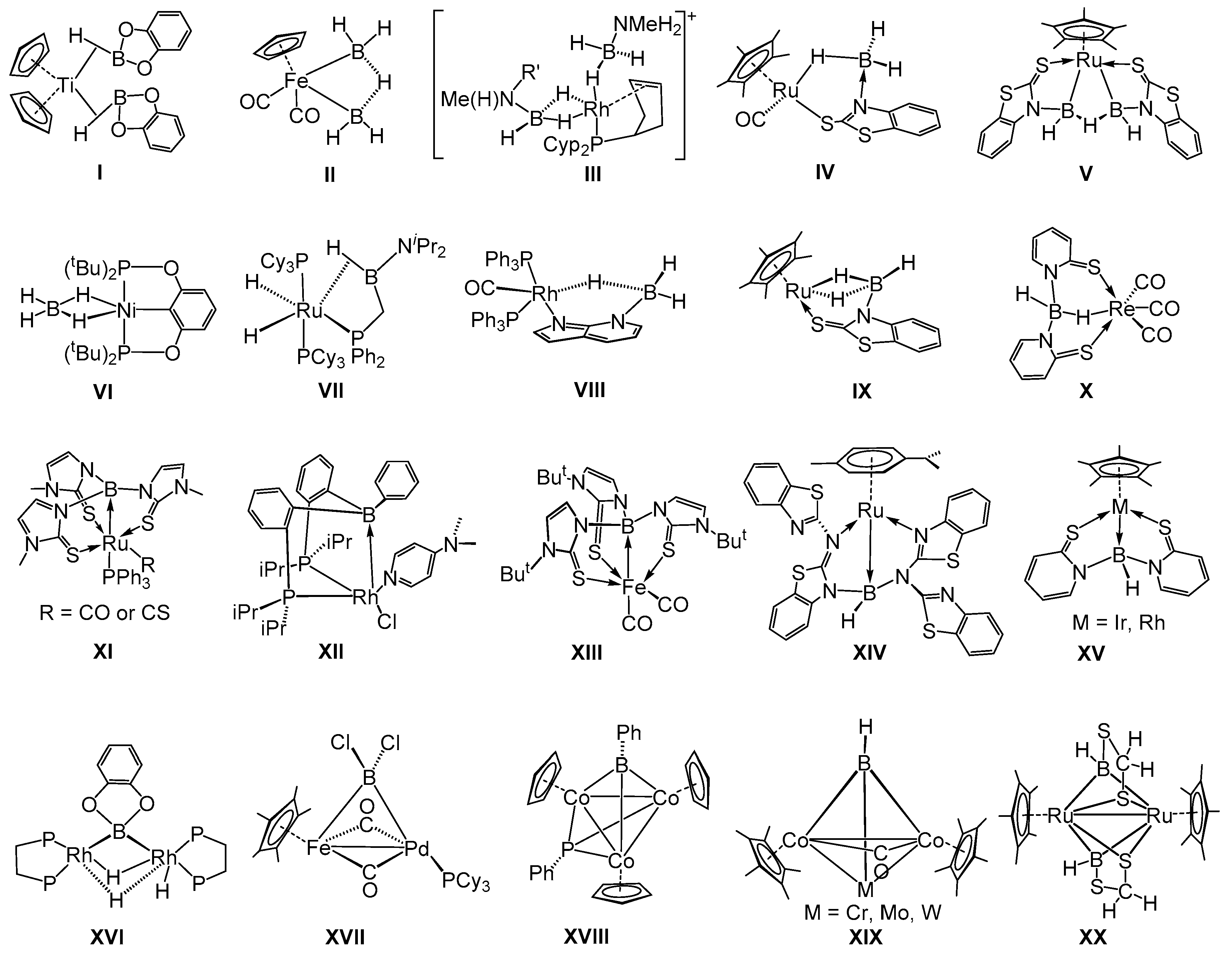

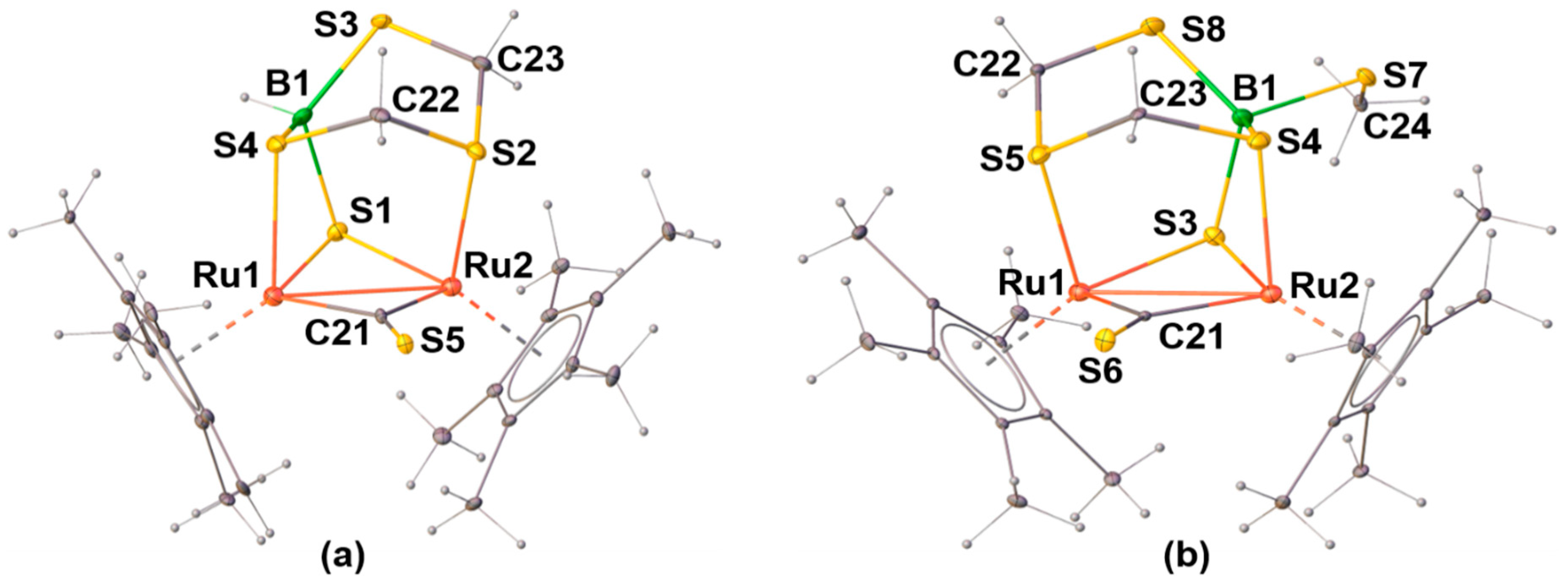
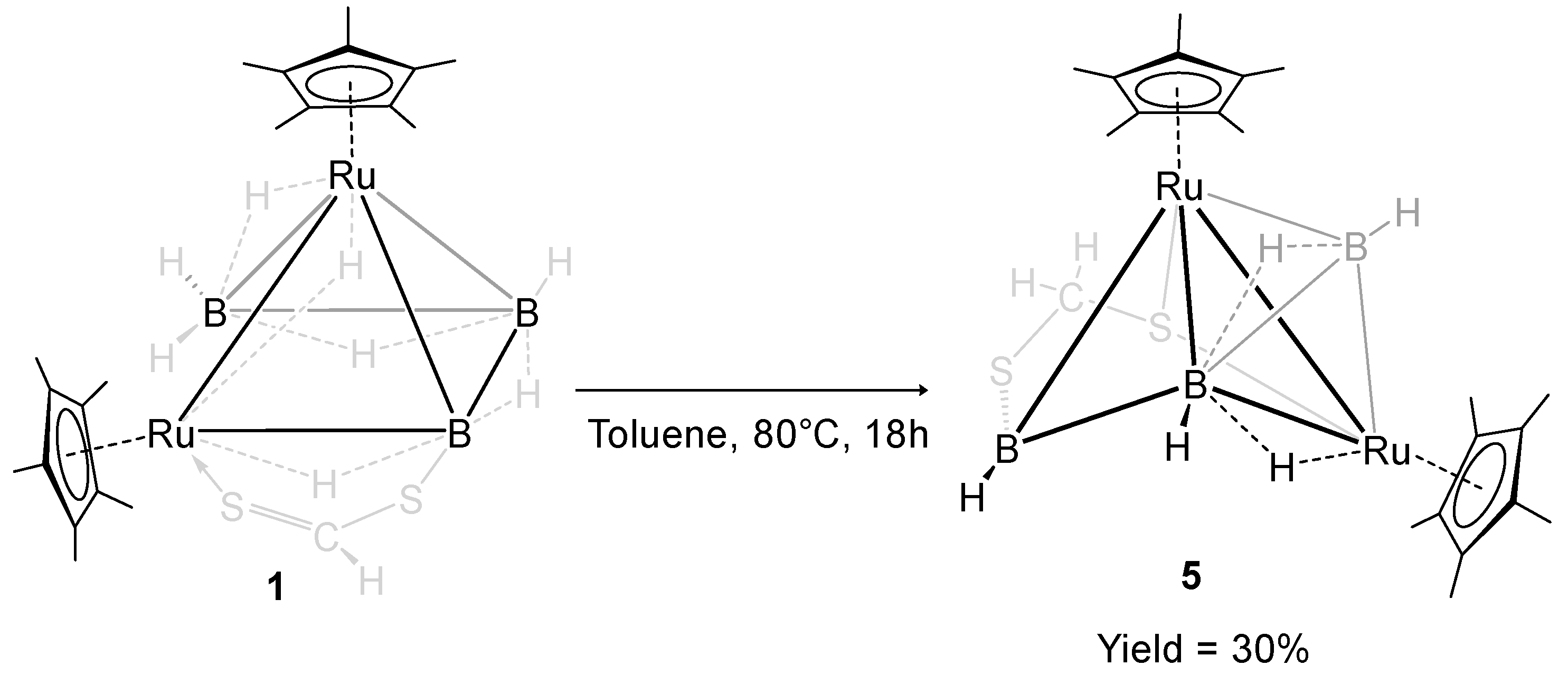

| Entry | 11B NMR (ppm) a | dav[B–E] b [Å] | Conformations c |
|---|---|---|---|
 | 8.3 d | 1.352 | half chair |
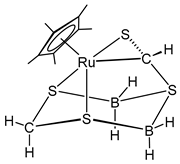 | −5.0 and −15.6 | 1.915 | chair |
 | f | 1.414 | planar |
 | 37.6 | 1.433 | boat |
 | −11.2 e | 1.943 | boat |
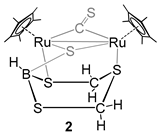 | −4.1 | 1.919 | boat |
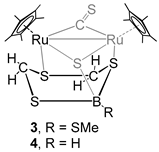 | 7.3 (3) 4.9 (4) | 1.923 f | Boat f |
© 2019 by the authors. Licensee MDPI, Basel, Switzerland. This article is an open access article distributed under the terms and conditions of the Creative Commons Attribution (CC BY) license (http://creativecommons.org/licenses/by/4.0/).
Share and Cite
Saha, K.; Kaur, U.; Borthakur, R.; Ghosh, S. Synthesis of Trithia-Borinane Complexes Stabilized in Diruthenium Core: [(Cp*Ru)2(η1-S)(η1-CS){(CH2)2S3BR}] (R = H or SMe). Inorganics 2019, 7, 21. https://doi.org/10.3390/inorganics7020021
Saha K, Kaur U, Borthakur R, Ghosh S. Synthesis of Trithia-Borinane Complexes Stabilized in Diruthenium Core: [(Cp*Ru)2(η1-S)(η1-CS){(CH2)2S3BR}] (R = H or SMe). Inorganics. 2019; 7(2):21. https://doi.org/10.3390/inorganics7020021
Chicago/Turabian StyleSaha, Koushik, Urminder Kaur, Rosmita Borthakur, and Sundargopal Ghosh. 2019. "Synthesis of Trithia-Borinane Complexes Stabilized in Diruthenium Core: [(Cp*Ru)2(η1-S)(η1-CS){(CH2)2S3BR}] (R = H or SMe)" Inorganics 7, no. 2: 21. https://doi.org/10.3390/inorganics7020021
APA StyleSaha, K., Kaur, U., Borthakur, R., & Ghosh, S. (2019). Synthesis of Trithia-Borinane Complexes Stabilized in Diruthenium Core: [(Cp*Ru)2(η1-S)(η1-CS){(CH2)2S3BR}] (R = H or SMe). Inorganics, 7(2), 21. https://doi.org/10.3390/inorganics7020021






